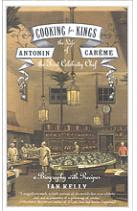 As I mentioned before, I’ve recently read Beau Brummell by Ian Kelly. I’m not going to attempt a review; it’s the first Brummell bio I’ve read and I haven’t the credentials to critique it from an academic standpoint. I found it a good read, both fascinating and depressing in places and would recommend it to anyone interested in this part of social history. Someone here said it went on rather long. I think the fact that nearly equal space was devoted to Brummell’s decline and death of syphilis as to the height of his popularity, what we usually see depicted in Regencies, made it hard work to read to the end. But that was his life, and a sobering story it is.
As I mentioned before, I’ve recently read Beau Brummell by Ian Kelly. I’m not going to attempt a review; it’s the first Brummell bio I’ve read and I haven’t the credentials to critique it from an academic standpoint. I found it a good read, both fascinating and depressing in places and would recommend it to anyone interested in this part of social history. Someone here said it went on rather long. I think the fact that nearly equal space was devoted to Brummell’s decline and death of syphilis as to the height of his popularity, what we usually see depicted in Regencies, made it hard work to read to the end. But that was his life, and a sobering story it is.
Anyway, to the tidbits.
 One thing that always puzzled me was whether to spell his name with one or two l’s. Two l’s always looked more English to me but I’d seen it both ways. The Author’s Note explains that Brummell’s first French biographer in the 1840s used a single l, but that his birth record has two l’s and that is the way he signed it. So I feel vindicated.
One thing that always puzzled me was whether to spell his name with one or two l’s. Two l’s always looked more English to me but I’d seen it both ways. The Author’s Note explains that Brummell’s first French biographer in the 1840s used a single l, but that his birth record has two l’s and that is the way he signed it. So I feel vindicated.
Brummell never sat for a full length portrait and I’ve never known how he really looked. The plate of miniatures and etchings in this book is not much help, which Kelly himself admits. Look at these guys! They don’t even look related, although I think the one on the middle right is hot. I like the sideways glance and the humorous quirk to his mouth. Right or wrong, this is how I’ll picture Brummell at his best.
So what do you think? Which of these pictures best reflects your idea of the Beau? And do you prefer two l’s or one?




